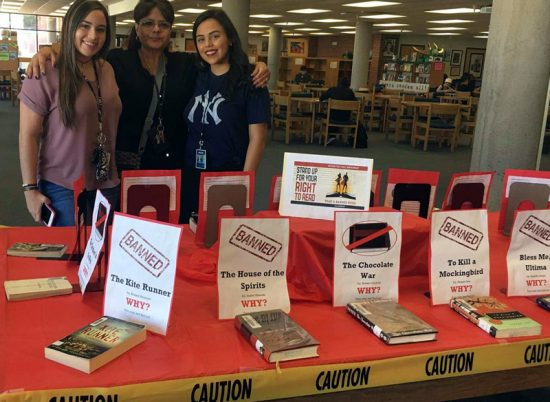By Yamilex Garcia and Omar Quintana
Before the fall break, Pueblo librarian Ms. Marsha-Jean Burrola constructed a display of banned books in commemoration of the Banned Books Week that began on Sept. 25 and lasted through Oct. 1. However, Burrola said that she wanted to leave the display for a few weeks after the break to maximize the number of students who viewed the banned literary works.
The Banned Books Week Coalition is a national alliance of diverse organizations joined by a commitment to increase awareness of the annual celebration of the freedom to read. The Coalition seeks to engage various communities and inspire participation in Banned Books Week through education, advocacy, and the creation of the programming about the problem of book censorship.
Senior Sara Noriega recently visited the Pueblo library and was dismayed at the number of banned books display, many that she has read in her lifetime.
“I was shocked to learn that some of my all-time favorite books have been banned, including To Kill A Mockingbird, just because of the use of the ‘n’ word,” Noriega said. “Back in the 1930s, in the South, the use of the ‘n’ word was prevalent, unfortunately. But, that’s just the way it was. Even though we know that the ‘n’ word is ugly and offensive, banning a book based on its authenticity and historical context is just ethically and socially wrong.”
She continued, “We live in America, which is supposed to be a democracy, and when I see books being banned, it reminds me of a world like that depicted in the movie and book Fahrenheit 451—a world where books are banned because how dare humans be allowed to think for themselves!”
Burrola explained how books get banned from school libraries. According to the American Library Association’s (ALA) web site, “A challenge is an attempt to remove or restrict materials, based upon the objections of a person or group. A banning is the removal of those materials. These challenges do not simply involve a person expressing a point of view; rather, they are an attempt to remove material from the curriculum or library, thereby restricting the access of others. As such, they are a threat to freedom of speech and choice.”
She continued that the National Council of Teachers of English (NCTE) Guideline, called The Student’s Right to Read, states that young people have an inalienable right to read books that offer diverse perspectives on their cultures and communities. Attempts at censorship deprive students of this right.
This book specifically states: “Censorship leaves students with an inadequate and distorted picture of the ideals, values, and problems of their culture. Writers may often represent their culture, or they may stand to the side and describe and evaluate that culture.”
Banned Books was launched in 1982 in response to a sudden surge in the number of challenges to books in schools, bookstores and libraries. More than 11,300 books have been challenged in the past 34 years, including Looking for Alaska; Fifty Shades of Grey; I Am Jazz; Beyond Magenta: Transgender Teens Speak Out and many more.


